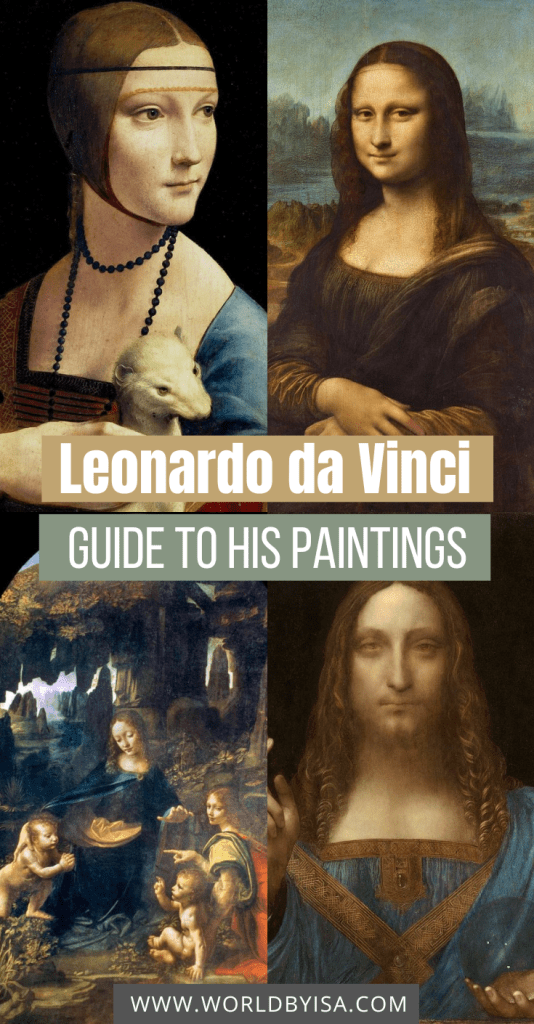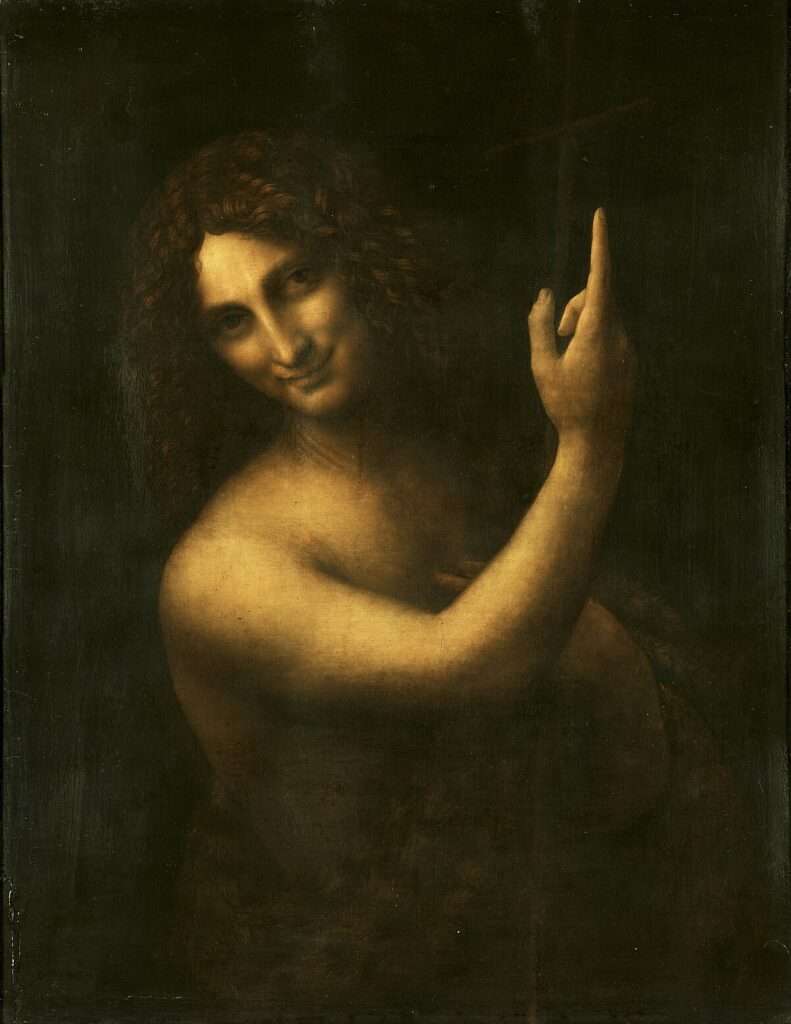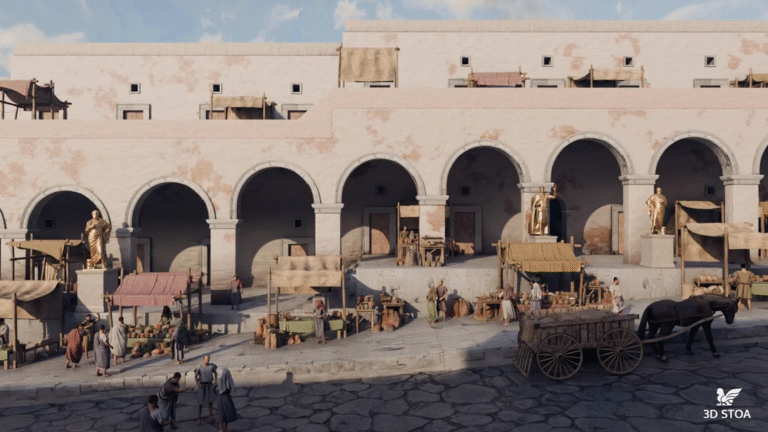15+ Famous Paintings by Leonardo da Vinci and Where to See Them
Painter, sculptor, architect, inventor, military engineer, and draftsman, have you ever thought of having so many skills? Does it sound possible? Well, for Leonardo Da Vinci it was.
This brilliant man knew a lot about many things and is one of the most prestigious and influential people ever set foot on this planet.
His famous art attracts thousands of people every day just for a short glance at his unique techniques.
Mona Lisa, Last Supper, and The Virgin of the Rocks, just to name a few.
But despite being one of the best painters that ever existed, Leonardo Da Vinci only painted a few pieces, researchers believe it was 25 in total.
From these 25 though, some are still debatable as being of his authorship, leaving us with only 15 paintings that proved to be authentic.
In this list, however, we will explore 17 of the most famous paintings by Leonardo da Vinci, two of them being disputed but with high chances of being authentic.

Disclosure: This post does contain affiliate links that I earn a small commission for at no extra cost to you. Any purchases you make through my links help keep the site running. Thanks in advance for your support!
About Leonardo da Vinci
Leonardo da Vinci, the visionary of the Renaissance, left an artistic legacy that transcends time.
His masterpiece, the Mona Lisa, is a treasure in the Louvre, and each visit to this icon reveals a new enigma behind that enigmatic smile.
But let’s go back to Da Vinci’s roots. His first work that has survived to this day is “The Baptism of Christ,” exhibited at the Uffizi Gallery in Florence.
Interestingly, this painting was not entirely his work, but a collaboration with his master, Andrea Verrocchio.
However, there is a hint of mystery about what da Vinci’s true first work was. Many believe that “The Archangel Gabriel,” a painting said to have been created by him at age 18, may be the answer.
His life stories intertwine with art, revealing a man whose talent and curiosity shaped the course of art history.
Famous Paintings by Leonardo da Vinci and Where to See Them

1. Mona Lisa
Leonardo da Vinci’s most famous painting, Mona Lisa, or, La Gioconda as it is also known, depicts Lisa del Giocondo, the wife of a rich merchant in Florence.
The painting was commissioned by her husband, but for some reason (probably because Da Vinci took too long to finish his art) the portrait was never delivered.
Read History and Curiosities of Mona Lisa.
Leonardo liked this specific portrait so much that it accompanied him even during his travels.
When Leonardo finally moved to Paris to work with King Francis I He took the painting with him, and later on, sold it to Francis I.
Mona Lisa ended up in the spotlight after being stolen by an Italian nationalist who mistaken her for art stolen from Italy during the Napolean Wars.
The portrait was rediscovered three years later, under the bed of a hotel room in Florence.
🎨Where to see the Mona Lisa: Louvre Museum, Paris.

2. St John the Baptist
Another kind of mysterious piece of Leonardo. St John the Baptist could be seen hanging next to the Virgin of the Rocks in Paris’ Louvre Museum.
It was loaned to Louvre Abu Dhabi in November 2022 for two years.
It is believed to be Da Vinci’s final piece and was painted between 1513 and 1516.
The painting depicts St John the Baptist as if emerging from the darkness.
The enigmatic way in which the Saint smiles, adds to the mysterious vibe of this painting and reminds us a bit of the Mona Lisa.
Just like many other paintings of Da Vinci, he used the sfumato technique, which blends the colors pretty well in this piece and softens the transition between the dark background to the light skin tone of the Saint.
Although it is hard to see, due to the colors of the painting, St John the Baptist holds a cross in his left hand, while his right hand points up, towards heaven.
Some believe that with this pose, Da Vinci wanted to represent the eternal question mark, the enigma of creation.
🎨Where to see St John the Baptist: Louvre Museum, Paris.

3. La Belle Ferronniere
Another famous portrait was painted by Da Vinci and is on display in the Louvre.
It is also known as Portrait of an Unknown Woman as the identity of the lady depicted was not clear.
Later, the lady was identified as Lucrezia Crivelli, wife of an ironmonger and lady-in-waiting to the Duchess of Milan, Beatrice of Milan.
Lucrezia was also one of the mistress of Beatrice’s husband Ludovico Sforza.
🎨Where to see the La Belle Ferronniere: Louvre Museum, Paris.

4. The Virgin and the Child with St Anne
In this painting, Leonardo depicts the Virgin Mary, her mother, St Anne, and infant Jesus.
Mary is sitting on her mother’s lap while she inclines to grab child Jesus, who is standing in front of them, holding a sacrificial lamb that lays next to him, symbolizing his Passion.
The painting that is now on display at the Louvre Museum was commissioned to be the altarpiece for the Basilica della Santissima Annunziata in Florence.
🎨Where to see the Virgin and the Child with St Anne: Louvre Museum, Paris.

5. The Virgin of the Rocks, Louvre
One of the two versions of this very same painting.
The earliest version is on display in the Louvre Museum in Paris, and the other one, in the National Gallery in London.
Both paintings are very similar; however, this first version was very controversial.
It gained popularity after its appearance in Dan Brown’s “The DaVinci Code”.
The painting was created in 1483 to adorn a wooden altarpiece in the Chapel of the Immaculate Conception.
Prior Bartolomeo Scorlione and the Confraternity contracted Leonardo Da Vinci and his assistants to create this artwork.
The Virgin of the Rocks, which is also known as Madonna of the Rocks, depicts Mary with her right arm around the infant St John the Baptist, who is depicted praying for the Christ child.
Christ’s child is seen blessing St John the Baptist in turn, and next to him is the angel Uriel, pointing at St John the Baptist. Above Christ Child, you see Mary’s left hand in a protective gesture over the head of her son.
The landscape is rocky and mysterious as if they were in a dark cave.
This first version though, was never hung at the Chapel of the Immaculate Conception.
🎨Where to see the Virgin of the Rocks: Louvre Museum, Paris.

6. The Virgin of the Rocks, London
When the first version of The Virgin of the Rocks was declined by the Church, Da Vinci saw himself obliged to recreate his art more softly.
Both paintings look very similar, the composition is still the same, as well as the scenario, but changes were made in the pose of the characters depicted.
The fingers of the Virgin Mary were softened, and the angel sitting next to the Christ Child is no longer pointing at John the Baptist. The colors are slightly different as well.
The painting was sold in 1781 by the Church to Gavin Hamilton, a Scottish painter and art dealer who brought the piece to England.
In 1880, it was acquired by the National Gallery, where the painting is still on display.
🎨Where to see the Virgin of the Rocks: National Gallery, London.

7. Vitruvian Man
Although it is not a painting, it is a drawing worth seeing by Leonardo da Vinci.
Leonardo created it in 1490 based on the work of the ancient Roman architect Vitruvius, who wrote about the proportions of the human body in his treatise “De Architectura”, hence the name.
This very well-known piece shows a nude man in two superimposed positions, with his arms and legs apart in a circle and a square, respectively.
Both the circle and the square have long been associated with Divine and earthly proportions throughout history.
The drawing is notable for its accuracy and exploration of the ideal proportions of the human body and has become an iconic symbol of the Renaissance.
It is a mix of the artistic and the scientific. It has been used for mathematical and geometrical purposes, being associated with the ‘golden ratio’, a mathematical proportion that is often found in nature and art.
🎨Where to see the Vitruvian Man: Gallerie dell’Accademia, Venice.

8. The Adoration of the Magi
Another unfinished parting of Leonardo was commissioned by the Augustinian monks of San Donato in Scopeto church, in Florence, when Leonardo was still living in the city.
As he moved to Milan in the following year, the painting remained unfinished.
Since 1670, the painting has been on display at the Uffizi Gallery in Florence.
The painting depicts the three wise men, or magi, kneeling in adoration while offering gifts to baby Jesus, while the Virgin Mary holds baby Jesus in the center of the image.
The scene is very crowded, with many layers of details, but the main subject of the painting forms a triangular shape in the center of the painting, giving it a pleasant proportion.
The rocky background is believed to be the ruins of the Basilica of Maxentius, a Roman ruin located in the Roman Forum, which can still be visited today.
As the medieval legend goes, Romans believed the Basilica would stand until the Virgin gave birth, having it collapse the day Jesus was born.
🎨Where to see the Adoration of the Magi: Uffizi Gallery, Florence.

9. The Annunciation
One of the earliest major works of da Vinci, from the time he was still an apprentice in Florence, was in the studio of Andrea del Verrocchio.
It depicts the famous biblical scene of the angel Gabriel on the left, announcing to the Virgin Mary on the right that she will give birth to Jesus.
Gabriel’s expressions convey a sense of urgency and importance, while Mary’s humble and reverent posture emphasizes her piety and devotion.
🎨Where to see the Annunciation: Uffizi Gallery, Florence.

10. The Last Supper
One of da Vinci’s most prestigious works.
The Last Supper depicts the final dinner that Jesus shared with his apostles before his crucifixion, according to the Gospels, specifically the seconds after Jesus announces that one of his apostles will betray him.
In the painting, you see the reaction of each apostle, showing different expressions,and you notice different degrees of anger, shock, and horror.
The Last Supper is now on display in the Santa Maria delle Grazie, a church in Milan, and was commissioned by Da Vinci’s patron, Ludovico Sforza, Duke of Milan, as part of the renovation of the church.
Don’t miss the chance to see The Last Supper in Santa Maria delle Grazie if you have a long layover in Milan. It is one of the highlights of the city and can be easily visited in a short time.
Leonardo had little experience with big frescos when he painted The Last Supper, and for this artwork, he chose unusual techniques, instead of what was commonly used in frescos.
The painting was made by applying experimental pigments directly on the dry plaster wall.
🎨Where to see the Last Supper: Santa Maria delle Grazie, Milan.

11. Portrait of a Musician
This unfinished painting was produced during Leonardo’s time in Milan, between 1483 and 1487.
It shows a different style from those we see by Leonardo da Vinci, he was probably influenced by the Early Netherlandish style of portrait.
The identity of the sitter is highly debated, but the positions of the portrait indicated a certain level of intimacy, so it was probably a private commission or the portrait of a close friend.
Until the 20th century, it was thought to be the portrait of Ludovico Sforza, the Duke of Milan, but during a restoration, it was revealed that the man in the portrait holds in his hand a sheet of music, indicating that he was a musician.
There were many active musicians in Milan back at that time, so it is hard to pinpoint one with certainty, especially with the lack of historical evidence, unfortunately.
🎨Where to see the Portrait of a Musician: Pinacoteca Ambrosiana, Milan.

12. Saint Jerome in the Wilderness
Another unfinished work of Leonardo.
This oil draft depicts Saint Jerome in his retreat in the Syrian desert, where he lived as a hermit.
The Saint is situated on a rocky landscape ,looking at a crucifix. He holds a rock in his right hand which he uses to beat his chest in penance.
Lying on his feet, we can see the lion that became his loyal companion after he removed a thorn from its paw.
The painting was originally bigger, but for some reason reduced in size at some point in history, and the part left was cut into five small pieces.
It was reassembled in the 19th century by Cardinal Fesch, a collector and uncle of Napoleon Bonaparte.
Later on, the painting was sold to Pope Pius IX ,and now the painting is part of the Vatican Museums collection.
🎨Where to see Saint Jerome in the Wilderness: Vatican Museums, Vatican.

13. Lady with an Ermine
Moving away, again, from religious subjects, let’s see now one of the only four portraits of females made by Da Vinci that survived to our time, well, at least those we know of…
This portrait depicts Cecilia Gallerani, the favorite mistress of Ludovico Sforza, Duke of Milan, and was painted between 1489 and 1491 during the time Leonardo da Vinci was working for the Duke as a painter in Milan.
In 1798, this painting was brought to Poland by Adam Jerzy Czartoryski, a Polish nobleman, and is now on display at the Czartoryski Museum.
In this portrait, Cecilia has an ermine resting in her arms.
Researchers claim that the animal was not owned by her, but rather added to the painting for its symbolism.
Ermines can symbolize purity, as Da Vinci himself noted many times in his diaries.
🎨Where to see the Lady with an Ermine: Czartoryski Museum, Kraków.

14. Benois Madonna
The Benois Madonna, also known as Madonna and Child with Flowers, was created around 1478 and 1480 during Leonardo’s early career.
It is believed that this was his first independent work.
It depicts the Virgin Mary, holding the child Jesus, reaching out to a sprig of flowers.
Although another person probably overpainted the painting, two preliminary sketches that are now part of the British Museum show that the drawing was actually from Leonardo da Vinci himself.
Benois Madonna proved to be a very popular artwork, being copied and reproduced by other young artists, including Raphael, who did his version, called Madonna of the Pinks, now on display at the National Gallery of London.
In the 1790s, the painting was acquired in Italy by a Russian general, and after being sold a couple of times, it ended up being inherited by the Benois family, hence the name.
Now, Benois Madonna can be seen at the Hermitage Museum in Saint Petersburg, Russia.
🎨Where to see the Benois Madonna: Hermitage Museum, Saint Petersburg.

15. Madonna of the Carnation
The Madonna of the Carnation depicts the Virgin Mary seated with baby Jesus on her lap, holding a carnation flower in her hand, the red of the flower representing blood or the Passion, perhaps.
This is another painting created by Leonardo during his time in Florence.
Some believe that the painting was created by Leonardo’s master, Andrea del Verrocchio, but some techniques used in this painting suggest that it is a work of da Vinci himself, perhaps from the time he was an apprentice to Verrocchio.
🎨Where to see the Madonna of the Carnation: Alte Pinakothek Museum, Munich.

16. Portrait of Ginevra de’Benci
A portrait of the Florentine aristocrat called Ginevra de’ Benci, from a wealthy merchant family, is associated.
The portrait probably commemorates her engagement or marriage to Luigi di Bernardo Niccolini, when she was around 16 years old.
At some point, the bottom part of the painting has been lost, probably due to damage, and now we are left with just the upper part of the portrait, showing a young girl gazing with indifference at the public.
It is the only painting by Leonardo on display in the Americas and can be seen on display at the National Gallery of Art in Washington.
🎨Where to see the Portrait of Ginevra de’Benci: National Gallery of Art, Washington.

17. Salvator Mundi
This painting, depicting Jesus making the sign of the Cross and holding a transparent crystal orb, is considered the most expensive Da Vinci painting (this is because Mona Lisa was never sold).
It is still disputable whether this art piece is an original work by Leonardo or if he just contributed to part of it. In one way or another, Salvator Mundi was part of an exhibition of Da Vinci’s work at the National Gallery in London between 2011 and 2012, after being rediscovered.
The painting was sold by Christie in New York to Prince Badr Bin Abdullah, the minister of culture of Saudi Arabia, for US$450.3 million.
🎨Where to see the Salvator Mundi: Unknown, will probably be on display in Saudi Arabia.
Read More:





